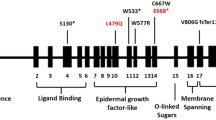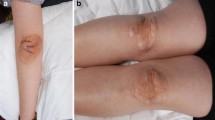Abstract
Autosomal dominant hypercholesterolemia (ADH) is caused by mutations in the genes coding for the low-density lipoprotein receptor (LDLR), apolipoprotein B-100 (APOB), or proprotein convertase subtilisin/kexin type 9 (PCSK9). In this study, a molecular analysis ofLDLR andAPOB was performed in a group of 378 unrelated ADH patients, to explore the mutation spectrum that causes hypercholesterolemia in Poland. All patients were clinically diagnosed with ADH according to a uniform protocol and internationally accepted WHO criteria. Mutational analysis included all exons, exon-intron boundaries and the promoter sequence of theLDLR, and a fragment of exon 26 ofAPOB. Additionally, the MLPA technique was applied to detect rearrangements withinLDLR. In total, 100 sequence variations were identified in 234 (62%) patients. WithinLDLR, 40 novel and 59 previously described sequence variations were detected. Of the 99LDLR sequence variations, 71 may be pathogenic mutations. The most frequentLDLR alteration was a point mutation p.G592E detected in 38 (10%) patients, followed by duplication of exons 4–8 found in 16 individuals (4.2%). Twenty-five cases (6.6%) demonstrated the p.R3527Q mutation ofAPOB. Our findings imply that major rearrangements of theLDLR gene as well as 2 point mutations (p.G592E inLDLR and p.R3527Q inAPOB) are frequent causes of ADH in Poland. However, the heterogeneity ofLDLR mutations detected in the studied group confirms the requirement for complex molecular studies of Polish ADH patients.
Similar content being viewed by others
References
Abifadel M, Varret M, Rabes JP, Allard D, Ouguerram K, Devillers M, et al. 2003. Mutations in PCSK9 cause autosomal dominant hypercholesterolemia. Nat Genet 34: 154–156.
Bednarska-Makaruk M, Bisko M, Pulawska MF, Hoffman-Zacharska D, Rodo M, Roszczynko M, et al. 2001. Familial defective apolipoprotein B-100 in a group of hypercholesterolaemic patients in Poland. Identification of a new mutation Thr3492Ile in the apolipoprotein B gene. Eur J Hum Genet 9: 836–842.
Boren J, Ekstrom U, Agren B, Nilsson-Ehle P, Innerarity TL, 2001. The molecular mechanism for the genetic disorder familial defective apolipoprotein B100. J Biol Chem 276: 9214–9218.
Brusgaard K, Jordan P, Hansen H, Hansen AB, Horder M, 2006. Molecular genetic analysis of 1053 Danish individuals with clinical signs offamilial hypercholesterolemia. Clin Genet 69: 277–283.
Civeira F, Ros E, Jarauta E, Plana N, Zambon D, Puzo J, et al. 2008. Comparison ofgenetic versus clinical diagnosis in familial hypercholesterolemia. Am J Cardiol 102: 1187–1193, 1193.e1.
Fisher E, Scharnagl H, Hoffmann MM, Kusterer K, Wittmann D,Wieland H, et al. 1999. Mutations in the apolipoprotein (apo) B-100 receptor-binding region: detection of apo B-100 (Arg3500—>Trp) associated with two new haplotypes and evidence that apo B-100 (Glu3405—>Gln) diminishes receptor-mediated uptake of LDL. Clin Chem 45: 1026–1038.
Fokkema IF, den Dunnen JT, Taschner PE, 2005. LOVD: easy creation of a locus-specific sequence variation database using an “LSDB-in-a-box” approach. Hum Mutat 26: 63–68.
Fouchier SW, Kastelein JJ, Defesche JC, 2005. Update of the molecular basis of familial hypercholesterolemia in The Netherlands. Hum Mutat 26: 550–556.
Gaffney D, Reid JM, Cameron IM, Vass K, Caslake MJ, Shepherd J, et al. 1995. Independent mutations at codon 3500 of the apolipoprotein B gene are associated withhyperlipidemia. Arterioscler Thromb Vasc Biol 15: 1025–1029.
Gorski B, Kubalska J, Naruszewicz M, Lubinski J, 1998. LDL-R and Apo-B-100 gene mutations in Polish familial hypercholesterolemias. Hum Genet 102: 562–565.
Hamalainen T, Palotie A, Aalto-Setala K, Kontula K, Tikkanen MJ, 1990. Absence of familial defective apolipoprotein B-100 in Finnish patients with elevated serum cholesterol. Atherosclerosis 82: 177–183.
Heath KE, Gudnason V, Humphries SE, Seed M, 1999. The type of mutation in the low density lipoprotein receptor gene influences the cholesterol-loweringresponse of the HMG-CoA reductase inhibitor simvastatin in patients with heterozygous familial hypercholesterolaemia. Atherosclerosis 143: 41–54.
Kalina A, Csaszar A, Czeizel AE, Romics L, Szaboki F, Szalai C, et al. 2001. Frequency of the R3500Q mutation of the apolipoprotein B-100 gene in a sample screened clinically for familial hypercholesterolemia in Hungary. Atherosclerosis 154: 247–251.
Kotze MJ, Peeters AV, Langenhoven E, Wauters JG, Van Gaal LF, 1994. Phenotypic expression and frequency of familial defective apolipoprotein B-100 in Belgian hypercholesterolemics. Atherosclerosis 111: 217–225.
Kubalska J, Chmara M, Limon J, Wierzbicka A, Prokurat S, Szaplyko J, et al. 2008. Clinical course of homozygous familial hypercholesterolemia during childhood: report on 4 unrelated patients with homozygous or compound heterozygous mutations in the LDLR gene. J Appl Genet 49: 109–113.
Kuhrova V, Francova H, Zapletalova P, Freiberger T, Fajkusova L, Hrabincova E, et al. 2002. Spectrum of low density lipoprotein receptor mutations in Czech hypercholesterolemic patients. Hum Mutat 19: 80.
Leren TP, Tonstad S, Gundersen KE, Bakken KS, Rodningen OK, Sundvold H, et al. 1997. Molecular genetics of familial hypercholesterolaemia in Norway. J Intern Med 241: 185–194.
Liyanage KE, Hooper AJ, Defesche JC, Burnett JR, van Bockxmeer FM, 2008. High-resolution melting analysis for detection of familial ligand-defective apolipoprotein B-100 mutations. Ann Clin Biochem 45: 170–176.
Lombardi MP, Redeker EJ, Defesche JC, Kamerling SW, Trip MD, Mannens MM, et al. 2000. Molecular genetic testing for familial hypercholesterolemia: spectrum of LDL receptor gene mutations in The Netherlands. Clin Genet 57: 116–124.
Miserez AR, Laager R, Chiodetti N, Keller U, 1994. High prevalence of familial defective apolipoprotein B-100 in Switzerland. J Lipid Res 35: 574–583.
Nissen H, Hansen PS, Faergeman O, Horder M, 1995. Mutation screening of the codon 3500 region of the apolipoprotein B gene by denaturing gradient-gel electrophoresis. Clin Chem 41: 419–423.
Plewa R, Luczak M, Burchardt P, Bolewski A, Wierzchowiecki J, Siminiak T, 2006. Monogenic hypercholesterolaemias—an evaluation of apolipoprotein B100 and LDL receptor gene polymorphisms. Kardiol Pol 64: 127–133; discussion 134.
Pullinger CR, Hennessy LK, Chatterton JE, Liu W, Love JA, Mendel CM, et al. 1995. Familial ligand-defective apolipoprotein B. Identification of a new mutation that decreases LDL receptor binding affinity. J Clin Invest 95: 1225–1234.
Schuster H, Rauh G, Muller S, Keller C, Wolfram G, Zollner N, 1992. Allele-specific and asymmetric polymerase chain reaction amplification in combination: a one step polymerase chain reaction protocol for rapid diagnosis of familial defective apolipoprotein B-100. Anal Biochem 204: 22–25.
Schwartz EI, Shevtsov SP, Kuchinski AP, Kovalev Y, Plutalov OV, Berlin Y, 1991. Approach to identification of a point mutation in apo B100 gene by means of a PCR-mediated site-directed mutagenesis. Nucleic Acids Res 19: 3752.
Soufi M, Sattler AM, Maerz W, Starke A, Herzum M, Maisch B, et al. 2004. A new but frequent mutation of apoB-100-apoB His3543Tyr. Atherosclerosis 174: 11–16.
Talmud PJ, Tamplin OJ, Heath K, Gaffney D, Day IN, Humphries SE, 1996. Rapid testing for three mutations causing familial defective apolipoprotein B100 in 562 patients with familial hypercholesterolaemia. Atherosclerosis 125: 135–137.
[WHO] World Health Organisation 1999. Familial hypercholesterolemia: Report of a second WHO consultation. Geneva: WHO Human Genetics Programme. WHO/HGN/FH/Cons/99.2.
Author information
Authors and Affiliations
Corresponding author
Rights and permissions
About this article
Cite this article
Chmara, M., Wasąg, B., Żuk, M. et al. Molecular characterization of Polish patients with familial hypercholesterolemia: novel and recurrentLDLR mutations. J Appl Genet 51, 95–106 (2010). https://doi.org/10.1007/BF03195716
Received:
Accepted:
Issue Date:
DOI: https://doi.org/10.1007/BF03195716




